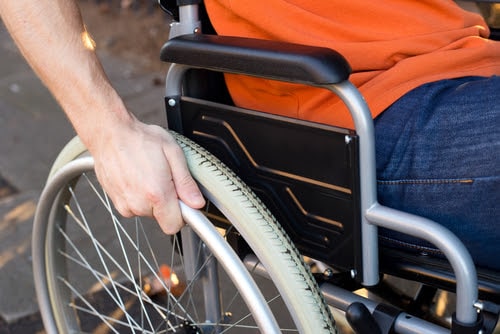Traumatic amputations involve the removal of a body part or limb due to an injury or accident. Traumatic amputations can vary from the removal of a single toe or finger to the loss of a whole leg or arm. Roughly 2 million people in the United States are currently living with an amputation, 45% of which were the result of trauma. The loss of a limb has serious impacts on a victim’s ability to work, the quality of their life, and their overall health. For almost 40 years, the experienced Hampton personal injury lawyers at Shapiro, Washburn & Sharp have been helping victims who have endured traumatic amputations pursue the financial compensation and justice they need to move on with their lives. Call us today to schedule your free case review.
What Are the Two Kinds of Traumatic Amputations?
Much like any other accident-related injury, no two traumatic amputations are the same. In some circumstances, like a serious vehicle accident, a victim’s limb could be detached from their body immediately. In other instances, a limb might be irreparably damaged by a severe burn injury or crushing accident.
Generally speaking, amputations fall under one of two types:
- Complete amputations: Complete amputations involve the detachment of an entire limb from the body. In some cases of complete amputations, surgeons may try to reattach a severed limb that has been preserved through a process called replantation surgery.
- Incomplete amputations: An incomplete amputation occurs when a portion of the soft tissues that connect the body to the limb are still intact. A partially severed limb may be able to be reattached to the body, but not always. For instance, a limb that is not fully severed but is badly damaged might require surgical removal.
In the case of either type of amputation, additional surgery may be needed to relieve chronic pain or address other problems that have developed.
What Are the Physical Effects of Traumatic Amputation?
Even though a traumatic amputation injury is severe enough on its own, it can potentially cause other serious physical impacts, such as:
- Mobility issues: After an amputation, even routine day-to-day tasks can be challenging. Once simple household chores can become cumbersome, or impossible to perform. It might also be extremely hard for victims to support themselves by earning a living.
- Infections: When the remaining skin on a stump deteriorates, it can cause an open wound to form, paving the way for massive infections and a heightened risk of serious blood clots. The treatment of these infections often requires another surgery to remove an additional portion or the remainder of the limb.
- Phantom limb syndrome: Phantom limb syndrome is a condition in which sensations, painful or otherwise, are experienced by amputees in limbs that no longer exist.
What Are the Leading Causes of Traumatic Amputation?
Accidents that lead to traumatic amputations are devastating for victims and almost always result in permanent disabilities. Although many types of accidents can lead to traumatic amputations, the most common are:
- Car accidents: Motor vehicle accidents, such as car, truck, and motorcycle crashes, are one of the primary causes of traumatic amputations. The powerful impact of an accident can easily remove an extremity or limb. Where vehicle accidents are concerned, a traumatic amputation can involve legs, arms, and even decollation.
- Construction accidents: Industrial accidents, especially those that occur on construction sites, cause multiple traumatic amputation injuries every year. In fact, data released by the Centers for Disease Control and Prevention shows that 20,000 amputation injuries occur every year from the use of mechanical power presses alone. Crushing accidents, equipment malfunctions, falls from a height, and other accidents can all lead to the loss of a body part or limb.
- Accidents involving explosives or firearms: Accidents involving fireworks, firearms, and explosives are another leading cause of traumatic amputations. In many cases, even if the blast or explosion itself did not cause an amputation, surgeons could deem it medically necessary to amputate a part of the victim’s body that has been irrevocably damaged by burn or blast injuries.
What Damages Are Available in a Traumatic Amputation Claim?
A traumatic amputation will adversely impact just about every part of a victim’s life. Since no two amputations are exactly the same, the damages you are eligible to claim will hinge on the specific facts of your accident.
Based on the circumstances of your amputation, you could be eligible to recover financial compensation for your:
- Current and projected medical bills
- Lost earnings
- Reduced or lost earning capacity
- Permanent scarring and disfigurement
- Emotional Suffering
- Physical pain
- Ongoing psychological and physical therapy
- Prosthetic limbs and other medical appliances
All We Do Is Injury Law
The experienced Hampton personal injury lawyers at Shapiro, Washburn & Sharp have witnessed first-hand the financial, emotional, and physical impacts that a traumatic amputation can have on a victim’s life. That is why we are dedicated to pursuing the maximum compensation you need and the justice you deserve for someone else’s negligence. That is exactly what we accomplished when we secured a $450,000 settlement for a motorcycle rider who underwent an amputation after being involved in a collision caused by another driver. If you or a loved one experienced a traumatic amputation or any other type of serious personal injury, you can schedule a free consultation with a skilled member of our legal team by calling (833) 997-1774 or filling out our online contact form. Our offices are located in Hampton, Norfolk, Portsmouth, Virginia Beach, and Chesapeake.
RELATED CONTENT
- What are Your Options After Suffering a Disabling Amputation Injury?
- Steps Vehicle Accident Victims Should Take
- Car Accident Guide
